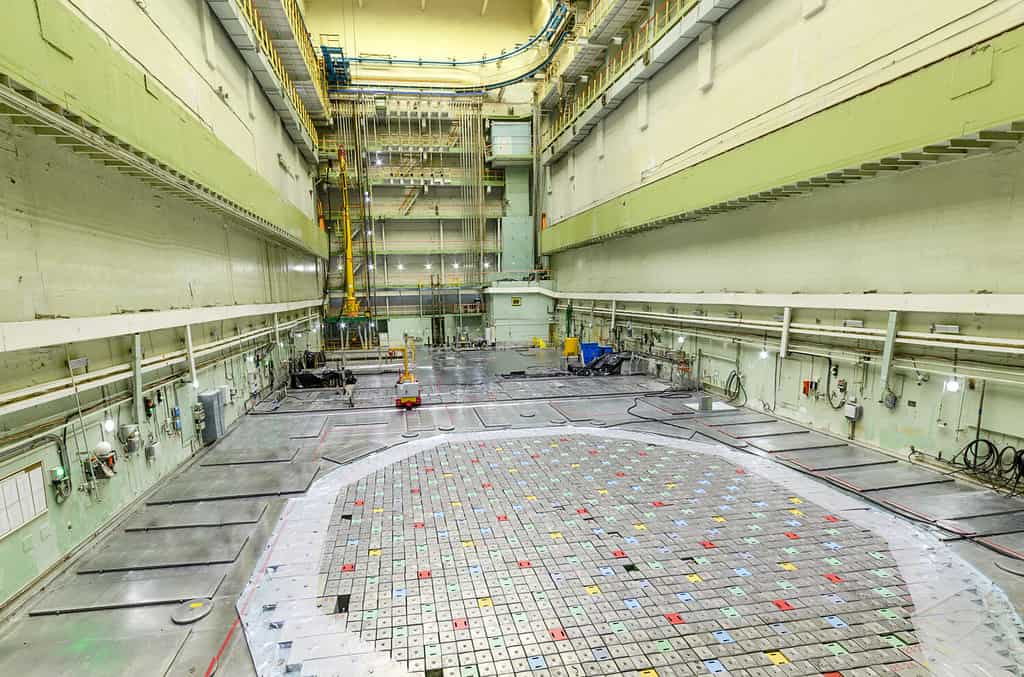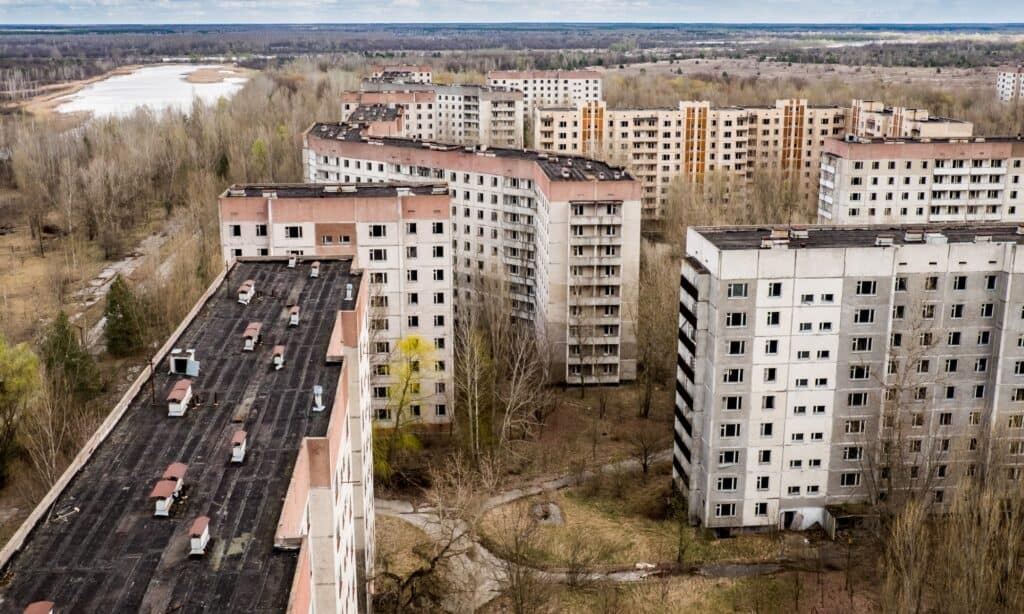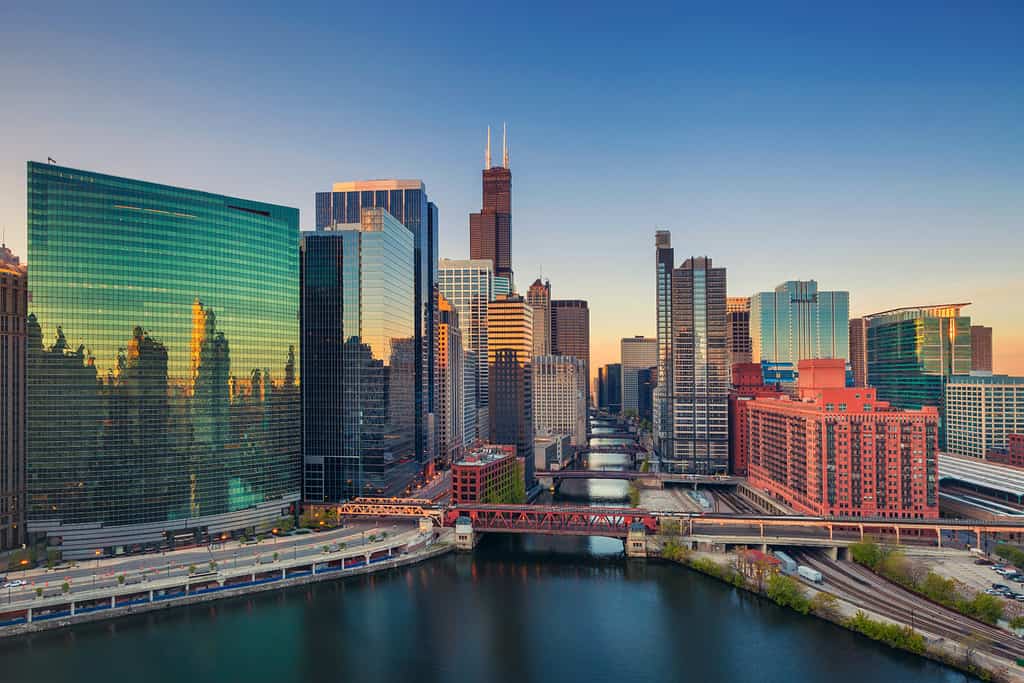It’s an exciting idea from horror movies: radiation leaks from a nuclear power plant, creating mutants or zombies. Or even worse, it explodes in a mushroom cloud. How accurate are these scenarios, really? Let’s find out by looking at the largest nuclear power plant in Illinois, one of our most populous states. Where is this plant and what lives around it? If you’re from Illinois, how close is it to your house . . . and are you ok with that?
How do Nuclear Power Plants Work?
The world runs on electricity. Regardless of the energy source, electricity is produced in one basic way. Humans find a way to turn the blades of a turbine, which turns a rotor that generates an electric field. You can rotate that rotor with the wind, the tides, water falling through a dam, or steam from hot water. You can heat the water by using the Earth’s geothermal energy, burning fossil fuels, or decaying radioactive elements. That’s where nuclear power comes in.
Radioactive uranium is processed into ceramic pellets and poured into fuel rods. Hundreds of radioactive fuel rods are bundled together in groups, and carefully placed in the core of a reactor. The uranium continually gives off energy and neutrons. Those neutrons collide with the nuclei of neighboring uranium atoms, releasing energy and more neutrons. When enough compressed uranium is in a small enough space, it can create a nuclear chain reaction with the most violently explosive results of any weapon science has ever devised. But, when you intersperse the fuel rods with lead rods, the lead slows down the reaction. Experienced staff can turn the heat up or down depending on the electricity needs.

This is the interior of a nuclear reactor. The area in the center contains the radioactive fuel rods.
©Nordroden/Shutterstock.com
Are Nuclear Power Plants Good for the Environment?
This is a controversial question. On the one hand, nuclear power does not pump carbon and other greenhouse gases into the atmosphere like fossil fuels do. On the other hand, uranium is much rarer than oil and has to be mined and processed, sometimes in remote areas. And building the plants requires a huge amount of materials and energy. All of these resources must be manufactured to precise specifications.
The biggest environmental problem of nuclear power is the radioactive waste it generates. Spent fuel rods and other radioactive materials have to be stored extremely carefully. They must be placed where no one will bother them for thousands of years while they decay into harmless materials. There is the possibility of radioactive materials leaking as they are transported to a storage site. It’s also possible that the storage facility itself may not survive the centuries it needs to. If it leaks, it will create contamination. There is also the problem of labeling these sites so that people of the distant future will understand. And we must keep in mind these future people may no longer speak our languages. Researchers and linguists are putting effort into designing pictographs they think future people will be able to decipher.
Accidents
A malfunctioning reactor could release radiation into the environment. In high enough doses, this can cause radiation burns, radiation poisoning, and death to living things. In lower doses, it can increase the risk of cancers, birth defects, and genetic mutations. And unfortunately, mutations produce neutral or negative effects on creatures, not gigantic growth or new superpowers.
Even without an accident, though, the normal operation of a nuclear power plant includes releasing steam into the atmosphere and warm water back into the river or lake it draws its cooling water from. The warmer water alters what kinds of algae and other plants and aquatic life live in the area. This can impact biodiversity in various ways in areas close to the reactor.

Thermal pollution from a reactor can cause algae growth and upset the ecological balance of waterways.
©iStock.com/Alexlky
Can a Nuclear Power Plant Blow Up?
The answer to this question is “yes” and “no.” A nuclear power plant is a complex facility that hires highly trained personnel and contains numerous electronic and mechanical systems. However, no system is 100% foolproof, so accidents can happen. A “meltdown” is a particularly dangerous accident in which a reactor overheats and can explode. Here are three of the most famous nuclear power accidents in history:
- Three Mile Island – The Three Mile Island plant in Pennsylvania overheated and leaked radiation in 1979. No injuries were recorded. But approximately two million people received a small dose of radiation (only about 1/6th as strong as a medical x-ray). Cleanup cost over $1 billion.
- Chernobyl – This reactor north of Kiev, Ukraine had an explosive meltdown in 1986. A combination of design flaws and negligence resulted in an explosion and fire. Only 31 deaths have been directly attributed to the accident, but citizens of Pripyat were forced to leave. In fact, over 300,000 people evacuated. Additionally, 600,000 people received disability benefits for their work cleaning up the site.
- Fukushima – In 2011, a massive earthquake triggered a tsunami, which damaged the Fukushima nuclear reactor in Japan. Water flooded the plant’s emergency diesel generators. The loss of power triggered a meltdown and forced the evacuation of 154,000 people.

The city of Pripyat, Ukraine remains abandoned as a result of the Chernobyl nuclear accident.
©iStock.com/Tijuana2014
Potential Explosions
While an explosion can scatter radioactive material, that’s not the same thing as a nuclear explosion due to nuclear reaction. To create an actual nuclear bomb, mushroom cloud, you have to compress highly enriched uranium into a small space. A conventional explosion forces it to compress still further and reach critical mass, in which a fission chain reaction occurs. The nuclear material in an energy-producing power plant is not enriched to weapons-grade. It is also not compressed to the point of reaching critical mass. The explosion that happens in a meltdown is more equivalent to a “dirty bomb,” in which an enemy might use a conventional explosion laced with radioactive materials to contaminate a large area with radioactivity.

A nuclear power plant can never cause explosion of this scale. It does not use weapons-grade uranium.
©iStock.com/RomoloTavani
What is the Largest Nuclear Power Plant in Illinois?
Braidwood Generating Station is the largest nuclear power plant in Illinois. It was built on an old strip-mining site at a cost of $5.2 billion and began operation in 1987. Located 60 miles southwest of Chicago in Will County, it generates nearly 2,400 net megawatts, enough to power over two million average homes. The site’s reactors are licensed by the Nuclear Regulatory Commission to continue operation until 2047. The plant employs about 755 people, as well as hundreds of temporary contractors when the plant is refueling.
Who and What Lives Near Braidwood?
Human Population
Will County has a population of 677,000 and is the fourth-largest county by population in the state. Joliet is the county seat and the third-largest city in the state, with over 150,000 people living there. But just 60 miles away are the 2.7 million residents of Chicago, making it the third-largest city by population in the United States. Chicago is also vitally important to the U.S. economy. Its gross metropolitan product was $770 billion in 2020, more than Switzerland and the third largest in the United States. Only New York and Los Angeles exceed Chicago in population and productivity.

Chicago, the third-largest city in the country, is just 60 miles from the Braidwood nuclear reactor.
©Rudy Balasko/Shutterstock.com
Wildlife
Illinois is home to a wide variety of wildlife. Among the most common species are white-tailed deer, chipmunks, squirrels, moles, shrews, rabbits and bats. Coyotes and bobcats are notable predators in the state. Coyotes have even been tracked living in urban Chicago. They hunt rats and other prey in the downtown areas at night. Seagulls, eagles, ospreys, and owls are some of the larger bird species. Songbirds like robins, cardinals, sparrows, blue jays, starlings, and mockingbirds are also prevalent. Fish species include bluegill, bass, crappies, warmouth, channel catfish, and perch. Reptiles include lizards, a variety of turtles, garter snakes, ratsnakes, kingsnakes, black snakes, and water snakes. There are four venomous snake species in the state: the copperhead, the cottonmouth, the timber rattlesnake, and the massasauga rattlesnake.

A large variety of songbirds live in Northern Illinois, including blue jays like this one.
©iStock.com/BrianEKushner
Why Build so Close to Cities?
It seems like madness to build nuclear power plants in such heavily populated areas, doesn’t it? Why not put them far out in unpopulated areas and transmit the electricity? Here are some reasons nuclear power plants are near cities:
- They go to nuclear-friendly states. Some states, like Hawaii, have banned them. Others, like Kansas, have tried to attract them with favorable tax deals.
- Transmitting electricity through powerlines loses a lot of energy.
- Because they cost billions of dollars to build and operate, they are near areas with healthy economies that will continue to grow in population and energy needs.
- Nuclear power plants take about 2,000 people to build, and construction can take decades. They take about 500 skilled technicians to continue operating. So they want to build in an area with an educated, skilled workforce. And people with those qualifications don’t want to live out their lives isolated in a desert.
- They need to be in an area that is not subject to earthquakes, tsunamis, or other natural disasters. They should be in a geologically stable location.
- They use a lot of water, so they need to be located by a river, lake, or ocean.

Nuclear power plants need a lot of water for cooling purposes, so they are by bodies of water.
©James Marvin Phelps/Shutterstock.com
What Safeguards Protect People and the Environment?
In the United States, the Nuclear Regulatory Commission holds nuclear reactors to strict standards and conducts regular inspections during the construction process and throughout the life of the reactor. Nuclear plants contain multiple failsafe systems so that human or mechanical error will not cause a disaster. They are designed to shut down automatically and safely if something goes wrong.
Workers at plants like these have to pass difficult certification exams and have regular additional training and drills throughout their careers to make sure they are up to speed on different possible emergencies and will react correctly under pressure. Hundreds of nuclear power plants around the world have routinely, and safely operated for decades with only a few accidents. Those accidents are not to be minimized, but technicians have learned from each of them and made corrections to design flaws and operating procedures to prevent similar errors in the future.
What Do You Think?
Now that you know how nuclear plants work and what some of their environmental advantages and dangers are, would you like to live close to the largest nuclear reactor in Illinois? Or maybe you already do. Some countries, like Germany, have made a decision to get rid of all nuclear power, even if that means temporarily increasing their use of greenhouse gas emissions from fossil fuels. Others, like France, are going all-in on nuclear, building more plants to replace fossil fuels completely with clean energy sources.
The photo featured at the top of this post is © Yurchanka Siarhei/Shutterstock.com
Thank you for reading! Have some feedback for us? Contact the AZ Animals editorial team.






